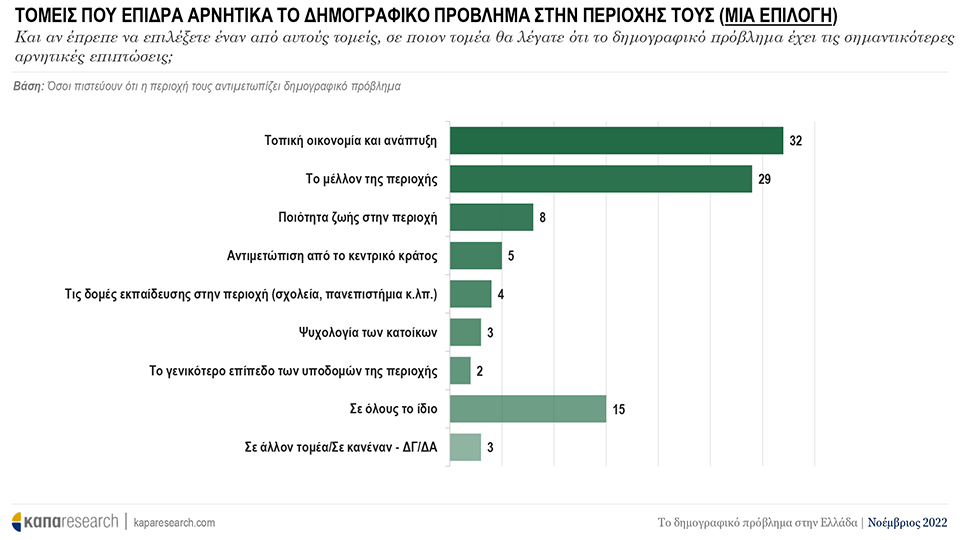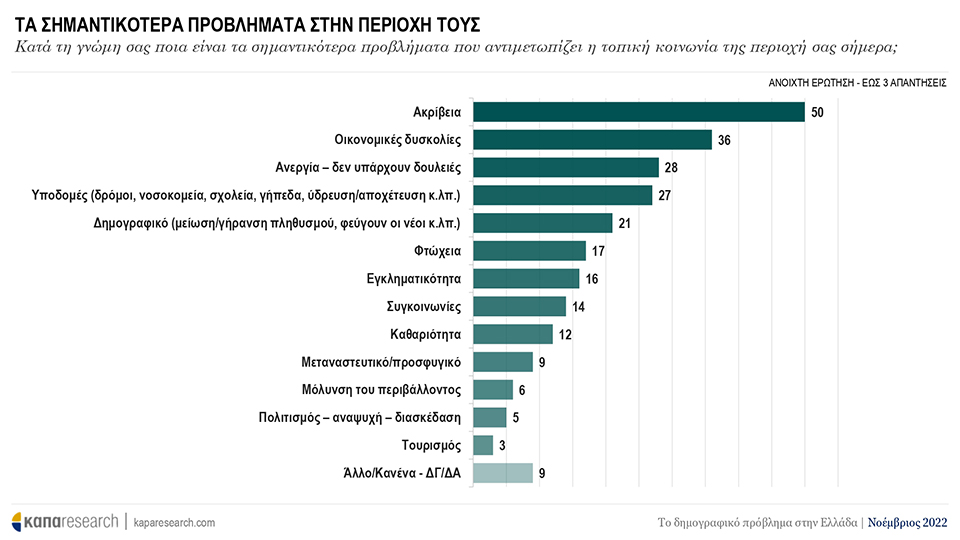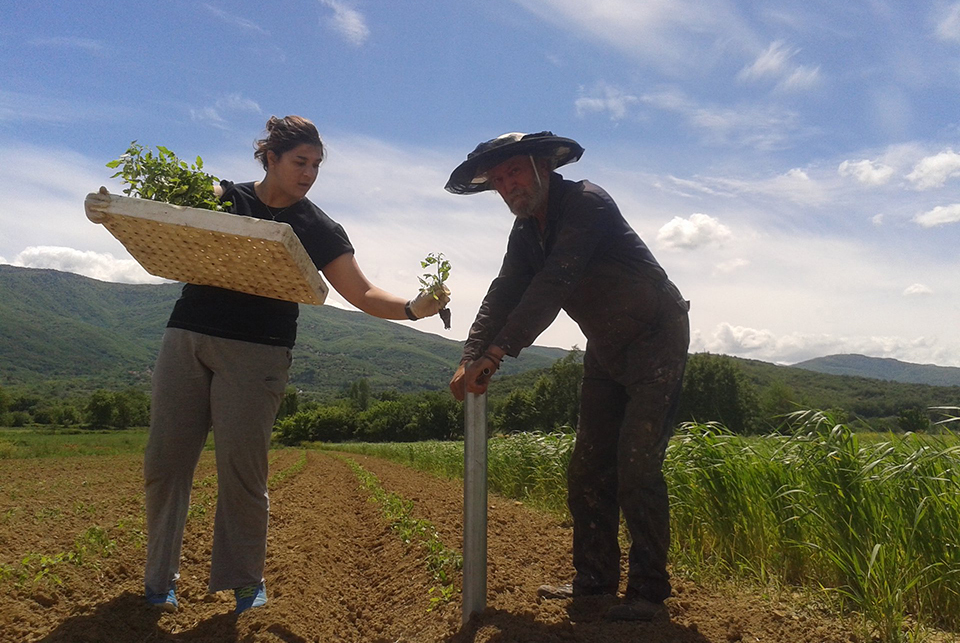
It has become a cliché. On every way back, from the village to the city after the end of the Easter holidays, there will be at least one person who will say with a sigh: “I wonder why we are returning. Didn’t we stay in our village to live well?” This romantic view of life in the village is, of course, far from reality, which is why usually those who formulate such questions forget them in the next half hour and return to their daily life, which for the vast majority will be either in Athens or Thessaloniki. And this is not what the writer says, but data that reveals the big picture. demographic gap between urban centers and rural areas in our country.
50% of the population in 2.9% of Greece.
According to ELSTAT, analyzed Byron Kotzamanisprofessor of demography at the Polytechnic School of the University of Thessaly and former director of the Laboratory for Demographic and Social Analysis (EDKA), 50% of our country’s population is concentrated on 2.9% of its surface, and 76 out of 100 residents now live in urban centers.. To understand the difference with the past, it is enough to note that in 1951 there were only 36 of them. Even more alarming for the future of the region is the age data. “In 1/3 of the municipalities we have more than two deaths per birth. These municipalities are mostly in rural areas, they are continental, mountainous or semi-mountainous. In Arta or Evrytania, the oldest prefecture in Europe, 4 out of 10 residents are over 65,” says Mr. Kotzamanis.
As he points out, the situation is irreversible. “We have municipalities where one birth corresponds to 20 deaths. What do you think should happen there?” the professor says, saying that the situation he describes is due to the model of regional development that was followed after the war.

Why are we leaving the village?
In connection with the fact that he is dealing with this issue, Heinrich Bell Foundation Greece recently published the results of a Greek-wide quantitative survey on the demographic problem in Greece, which was conducted last November in collaboration with the research company Kapa Research.
According to the data received, 32% of respondents answered that the area that most negatively affects the demographic problem of their region is the local economy and development, and 29% – the future of the region. In particular, when asked what is the most important reason for the population decline in their area, 29% answered that there are no jobs that provide a decent life, 26% that there are no prospects for economic development, and 6% that there is no suitable infrastructure such as healthcare, education and roads. For respondents living in rural areas, demographic factors are the biggest problem, followed by punctuality, unemployment, and economic hardship.

“We all know that there is a very large over-concentration in Greece, mainly in Athens but also in major urban centers, an over-concentration of population, opportunity, economic and political power. Taking it for granted, we thought we’d look beyond it. This blatant disparity and imbalance is a horizontal issue that worries us. We believe, however, that it is too underestimated in public debate, especially in a year when we have elections at all levels, ”emphasizes in an interview with“ K ” Michalis Gudis, Director of the Foundation. As he points out, in Greece, demographics are almost exclusively linked to population growth rates in absolute terms, while in other European countries, such as Germany, the question of how they will be shaped is explicitly posed in the context of elections and green development conditions. equality between large urban centers and the periphery.
In our country, “back to the village” this was practiced on a number of occasions during the crisis decade. During this period, interesting ideas and innovative projects were created both by the indigenous population and by young people who decided to return to their places of origin, which, among other things, was aimed at retaining the local population through income generation. But even these alone do not seem to provide solutions.

“Each route takes more than an hour”
OUR White Taya works at one of these enterprises, in a semi-mountain village paleo rock west Phthiotidas, on the slope of Mount Gulinas. A 42-year-old woman works in social cooperative enterprise Paliobracha, founded by her family along with some others, with the aim of selling organically grown local products, as well as empowering the village. Despite the good development of the business, which sent product samples abroad for the first time a few days ago, Aspa she is the only one of her three siblings who lives in the village and is involved in this project.. “One of my sons is a surveyor and the other is a military man. What are they doing here?” her mother says. Poppy Taya. However, even Aspa returned to the countryside after her studies because she accidentally met her then partner and now her husband there. “For a young person, living in a rural area is normal from the point of view of psychology and health. Life and rhythms are calmer. In terms of work and finances, however, it is difficult.“, – he admits. She is the only one of the classmates who remained in Palaiobracha. According to her, 75% of them now live in Athens, and two of her classmates who returned to more remote areas work in the public sector.
The problems, however, do not end there. For the children of the village to go to school they are forced to do 6 or 8 kilometerswhich they travel with the help of a school bus hired by the municipality. However, if they want to do extra-curricular activities like tutoring or sports, things get tricky as the only solution is Lamia.. “Once a day, at noon, a bus passes by and drops you off at Lamia. It passes through all the villages and on the way back, in the evening, leaves you at Sperchiada and from there you have to take a taxi to get to the village. Each route takes more than an hour,” Ms Taya says, adding that when she once worked in Lamia, she had to wake up every day at 3 am to get to work at 6 am. When asked if he experienced any government support, he almost laughs. “Don’t talk to me about the state. There is no”.

Innovations in Zagorohorie
A woman who decided to leave Athens and move to Epirus faced similar but different problems. For about seven years he said resident of Elafotopos in Zagorochoria Stella Prasinu she would finish her work at about 4pm, then enjoy a walk with her dog in nature, and later be encouraged to find creative ways to enjoy the rest of the day.
The young woman is one of its founders. Bad projectan award-winning initiative that has begun using local sheep wool in Zagorohorie – which until then, despite its great value, had been thrown into the trash – and processed into woolen products with the help of artisans. Pokari has begun using sheep’s wool to create jobs for residents, additional income for the farmers who will supply the wool, and a product that is environmentally friendly and a circular economy. The first collection of products, such as carpets, has already been created, and all participants in the initiative hope that this pioneering effort will soon bear fruit.
However, until this is done and the established social cooperative enterprise does not generate income, Ms. he was forced to return to Athens. The main reason was financial.
The young woman moved to the countryside to study at the Risario vocational school in Monodendri, Ioannina. When she was offered a job at the School, she accepted and began to live normally in the area. As he describes in “K”, the problems were many: houses in good condition were hard to come by, and the few that did exist were quite expensive, and the winter was harsh, making it difficult for anyone to move or heat their premises. . However, the biggest problem was lack of employment opportunities. “With a basic salary, you cannot cover your needs. However, in a big city, you can maneuver in terms of work and work more than one job. There are practically no or few employment opportunities in the region,” he stresses. While the young woman admits that she enjoys the life she has led in the countryside and would love to, she acknowledges that development opportunities are limited, when a person is so cut off from the city center.

It will take decades to change the situation
The experiential experience of the two women translates into an experience that the study recorded in percentages and numbers.
As communication problems persist, schools close and buildings run out, the gap between rural and urban centers is expected to widen, with devastating consequences for the country and its people.
“This situation is not easy to change, it cannot be changed in a decade,” comments Mr. Kotzamanis. “We have not implemented the policy of regional development for so many years, and this worked cumulatively. The longer you let it fester, the harder it is to reverse it.”
Source: Kathimerini
Ashley Bailey is a talented author and journalist known for her writing on trending topics. Currently working at 247 news reel, she brings readers fresh perspectives on current issues. With her well-researched and thought-provoking articles, she captures the zeitgeist and stays ahead of the latest trends. Ashley’s writing is a must-read for anyone interested in staying up-to-date with the latest developments.